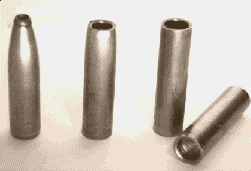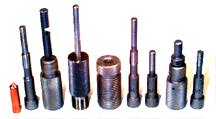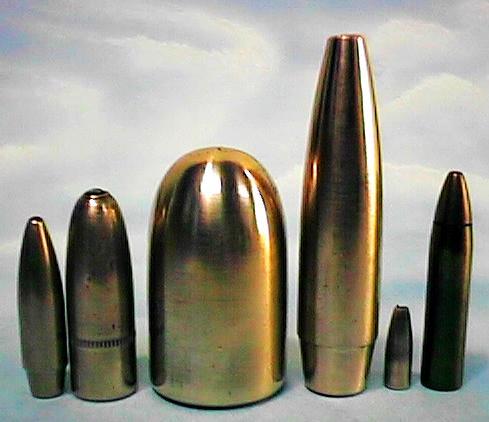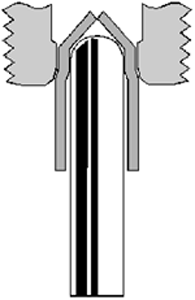| Home | Presses | Intro | Site Map | P.R. | Chemicals | Answers |

|
| Prices | Specials | How To | Bullets | B.Makers | Books | Classified | |
| Topics | Jackets | Terms | Training | Software | Products | Contact us |
| Home | Presses | Intro | Site Map | P.R. | Chemicals | Answers |

|
| Prices | Specials | How To | Bullets | B.Makers | Books | Classified | |
| Topics | Jackets | Terms | Training | Software | Products | Contact us |
|
|
|

Tubing Jackets |
|

|
All Corbin swage presses can make bullet jackets from copper tubing. The CSP-1 (S-Press) can build calibers from .22 to .458 up to about 1.25 inch length. The CSP-2 (Mega Mite) can make from .22 to .50 caliber jackets in any reasonable length. The CHP-1 (Hydro Press) can swage almost any caliber up to 1 inch diameter. There may be specific limits for certain thicknesses, materials, and designs, but in general, there is a way to make closed-base, high grade jackets from tubing in nearly any style or caliber including rebated boattail and FMJ. |
For big game hunting, and any time you need a tough, slow expanding jacket for high velocity work, the COPPER TUBING JACKET is ideal. You would always use LARGER tubing than the final diameter of bullet except for .50 caliber (1/2-inch tubing). The sizes commonly used for all calibers from .512 down to .257 are:

The steps to make tubing jackets are simple: cut pieces of tubing from straight, hard drawn tubing (or annealed, soft tubing without kinks and bends). You can use a tubing cutter saw for quick, precise cuts. Tubing cutters of the typical plumbing type roll the material too much and have no length setting. Debur one end of the tubing, so it will slip over a punch that is snug to the I.D. |
|

|
Slip the tube over the first punch in the die set until it rests on a shoulder, and push the punch and jacket into the END ROUNDING DIE, to roll one end over and nearly close it (or close it fully in a hydraulic press). The end rounding die is not caliber specific: it is designed for a certain diameter of tubing. The punch which fits inside this die is designed for that diameter AND wall thickness of tubing. You can change wall thicknesses and use the same die, if you change the external punch to match the new tubing thickness. |
|
The diameter is specific to the die (original tubing diameter). The wall thickness is specific to the external punch, for a given diameter. And the length of the jacket is specific to the length of the punch tip. A section of the punch fits inside the tubing, which butts up against a shoulder on the punch. The tubing is usually about 1/2 caliber longer than the punch tip, so an unsupported portion projects beyond the punch and is pushed over, to form an angled base section, within the die.
If you try to use much longer tubing, it may buckle and fold because too much of it is not supported by the punch. If you try to use too short a piece of tubing, it will not be able to fold over the punch tip and may damage the punch or break the die if you push harder and harder, attempting to do the impossible with the wrong punch or jacket length. You can always purchase another punch with a different length of tip, to make other jacket lengths, provided the over-all length of the tube before rolling the end over will fit completely into the die. Please note that the tubing can be nearly or completely closed on the base, especially when using a Hydro-press. Even with a hand press, the open spot in the base is very small, usually about 1/8 inch, so it poses no problem (compare military open base bullets, for example, with have 90% of their core exposed in some cases). | |

|
Push the jacket through the JRD-1 JACKET REDUCING DIE (if necessary, and it usually is except for some 50 caliber bullet jackets made from 1/2-inch tubing). This die is part of the CTJM-1 set. The punch fits into the press ram, and the die screws into the press head, just the opposite from most bullet swage dies. You must remove the floating punch holder, from the press head, in order to install the jacket reducing die. |
|
At this point, the set becomes specific to one caliber. You may be able to change the components from this point on, and use the same set for several calibers (provided they all start with the same tubing diameter and wall thickness). The drawing punch may fit more than one wall thickness of tubing, or it may not, depending on which direction you go and how much different the two thicknesses are. This is determined case by case.
If you expect to make more than one wall thickess or caliber of jacket, it is wise to plan all of them at once so that the extra parts can be made, and tested, along with the original set of dies. That way, you may save money by re-using some parts for different calibers or wall thicknesses. However, the punch drives the jacket through the die by pressing on the ID of the base, so the jacket length is not critical for this punch. Now, anneal the jacket. This is done by heating the jacket to the point where you can see it glow red in a dimly lighted room, then dunking it in water to knock off the scale that might form. Water isn't needed for annealing; it has nothing to do with hardness but only aids in cleaning and making the jackets safe to handle quickly. Some people try to skip this step, but it is a mistake to do so: the operation of the rest of the set depends on a known jacket hardness. If you fail to anneal properly, the jacket may stick on the punch, buckle and fold, or produce a bullet which is the wrong diameter by as much as several thousandths of an inch in the same dies that would normally produce exactly what you wanted, if you had only annealed the tubing. |
|

|
Using your existing CORE SEATING die, from your bullet swage die set, plus the special END FLATTENING PUNCH provided with the tubing jacket maker set, put the tubing jacket over the punch and push it into the die, which will FLATTEN the end (it was formerly rounded or conical shaped). If the tubing tries to stick on the punch and does not want to release easily, then the problem could be insufficient lubricant inside the jacket or on the punch, incorrect or missing anneal, or the wrong diameter/wall thickness of tubing for the particular punch. Wall thickness is critical with tubing jackets: anything works, but only if the set was made for it. If you have more than one thickness of jacket (.030, .032 for example) then you may want to get a second set of punches for the other thickness. |

|
You now have a finished jacket with a flat base! It can be used like any other jacket, except the walls are thicker than usual. Typical wall thickness is .030-.035 for the hand presses, and the .049 and .065 inch thickness for type -H dies used in hydraulic presses. Of course you would select the thickness appropriate to the task: North American game hunting normally is perfect for .030 wall jackets (especially using Bonded Core designs). |
|
If you change wall thickness or length of tubing, you may need to change the end flattening punch to match. Sometimes you can use the same punch with different lengths, if you are making a shorter jacket than the original design. If you are making a longer jacket than the design for the set, it may buckle and stick on a punch that was made for a shorter jacket. And if you change the wall thickness, you will certainly need to get a different punch to avoid problems.
If you change calibers (by getting a different JRD-1 Jacket Reducing Die and punch set), you will need a different end flattening punch as well. Fortunately, these parts are relatively inexpensive, and can quickly expand your jacket-making capability with less cost than a complete new jacket making set. In some cases, the difference between the original design and the new caliber is just too great and you do need the complete set for good results. For example, a .458 jacket making set can be used for .452, .448, .429, and .40 caliber but it would not work very well for .375 or smaller calibers. The .375 set would work fine for .366, .358, .348, .338 and .323 (8mm), but when you get to .318 and smaller, a new complete set gives far better results. From .318 down to .264, you can adapt the original set with draw die, draw punch, and end-flattening punch alone, but for .257 and smaller, you should switch to a different set. The cost of converting for other calibers is the standard price of the punch and the JRD-1 die, depending on which press you use. None of the jacket making sets is suitable for use in a reloading press. The CSP-1 press uses type -M or -S dies and punches. The CSP-2 Mega Mite and Hydro Press all use the -H dies and punches. As long as a given caliber uses the same starting diameter and wall thickness of tubing, and the length is not changed from the original design for the set, you can get the reducing die/punch set and the end flattening punch, and make other calibers. If the length of the new jacket will also change, then you need a different end rounding punch (first step) as well. This is always true when you change the length of the jacket, regardless of whether it is the same or different caliber. If you change the tubing wall thickness, you need a new end rounding and a new end flattening punch, and sometimes you may need a new punch for the reducing die as well. But all these additions are far, far less than the cost of an entire new set of jacket making dies. Copper tubing can be purchased from Corbin in two ways. First, you can purchase 4-foot sections which you then cut to length yourself. You can purchase a special copper cutting blade for your table saw or miter box saw (carbide tipped, special rake and set for copper or for thin laminate materials). Second, you can purchase lathe-cut pieces, which are sold by the cut inch with one end-deburred (the other end faces the bottom and does not need any further processing before forming the jacket base). Cutting tubing with a conventional rotary tubing cutter rolls the end so much that it is hard to get over the punch, and is not especially precise in regard to length of cut piece. A fine-tooth bladed tubing saw is recommended if you cut your own tubing lengths. |
|
|
Cat.No.
3-ft. pc. 1-in cut. |
Weight
Per 3-ft. Per ft. |
Diameter
Wall thick. |
|
TU-250-3
TU-250-1 |
.2748-lb.
.0076-lb. |
1/4-in.
.028-in. |
|
TU-313-3
TU-313-1 |
.3540-lb.
.0098-lb. |
5/16-in.
.035-in. |
|
TU-250-3
TU-250-1 |
.4350-lb.
.0121-lb. |
3/8-in.
.035-in. |
|
TU-500-3
TU-500-1 |
.5940-lb.
.0165-lb. |
1/2-in.
.035-in. |
|
to order books by e-mail (VISA/MC Welcome): sales@corbins.com |
| Home Page | Price List | E-Mail Sales | Site Map | New Products | Q&A | Terminology |
| Retirement | Specials | Real Estate | Software | How to swage | Classified Ads | Feedback |